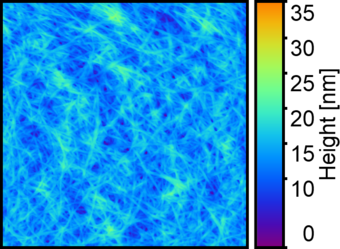Nano-Papier zum Sprühen
Neues Verfahren erzeugt dünne Zelluloseschichten im industriellen Maßstab
2019-07-09 – Nachrichten aus dem Physik-Department

„Poröse, nanostrukturierte Zellulosefilme besitzen eine Reihe vorteilhafter Eigenschaften, die sie für verschiedene Anwendungen interessant machen“, erläutert der Erstautor der Studie, Calvin Brett von DESY und der Königlich-Technischen Hochschule (KTH) Stockholm. „Sie sind leicht und temperaturstabil, haben hervorragende mechanische Eigenschaften, eine geringe Dichte und bestehen aus nachwachsenden Rohstoffen – die Zellulose-Nanofasern werden in der Regel aus Holz gewonnen.“
Eine Alternative zu Plastik
Damit sind die Zellulosefilme eine vielversprechende Alternative zu mineralölbasierten Kunststoffen und aussichtreiche Kandidaten für die Konstruktion von funktionalen Materialien wie Bio-Verbundwerkstoffen oder biologisch inspirierten Sensoren. So lassen sich beispielsweise funktionale Polymere oder andere Stoffe in die Poren des Zellulosefilms einbringen, um bestimmte Funktionen zu erzeugen.
Bei dem an der KTH Stockholm und bei DESY entwickelten Verfahren werden Zellulose-Nanofasern mit einer mittleren Länge von 500 Nanometern (millionstel Millimetern) und einer typischen Dicke von 3 bis 5 Nanometern in einer wasserhaltigen Trägerflüssigkeit auf einen Siliziumträger gesprüht. Das Trägermaterial wird auf 120 Grad Celsius aufgeheizt, um einen Teil des Wassers zügig zu verdampfen und die Zelluloseschicht so zu stabilisieren. Es entsteht eine extrem gelichmäßige, nur 200 Nanometer dünne Zelluloseschicht – eine Art ultradünnes und extrem glattes Papier. „Eine Kernfrage für die richtigen Eigenschaften ist dabei das Verhältnis zwischen der Schichtung der individuellen Nanofasern, der Porosität und der Nanostruktur innerhalb des Zellulosefilms“, erläutert Roth, der auch Professor an der KTH Stockholm ist.
Bei DESY untersuchte das Team die innere Struktur der Zellulosefilme mit Röntgenstrahlung. Die Analysen zeigten, dass die Menge des im fertigen Zellulosefilm noch gebundenen Wassers mit der elektrischen Oberflächenladung der aufgesprühten Nanofasern zunimmt. Diese elektrische Ladung lässt sich während der Produktion gezielt beeinflussen und so die Eigenschaften des Films steuern. Gleichzeitig zeigten Untersuchungen mit dem Rasterkraftmikroskop, dass die Rauigkeit des Zellulosefilms mit steigender Oberflächenladung abnimmt. Je stärker die Einzelfasern elektrisch geladen sind, desto glatter wird der Film.
Neutronen zeigen Eigenschaften beim Benetzen und Trocknen

Weil Wasser besonders empfindlich von Neutronen nachgewiesen werden kann, nutzten die Forscher die Kleinwinkelstreuanlage KWS-1 des Forschungszentrums Jülich am Heinz Maier-Leibnitz Zentrum (MLZ) in Garching. Sie untersuchten, welche Folgen es hat, wenn das Material benetzt und getrocknet wird, und analysierten die Hohlräume im Film, in die sich funktionale Stoffe wie Polymere oder Metalle einschleusen lassen. Die Neutronenmessungen führten der Instrumentwissenschaftler Dr. Henrich Frielinghaus und die Wissenschaftler des Lehrstuhls für Funktionelle Materialien von Prof. Dr. Peter Müller-Buschbaum an der Technischen Universität München gemeinsam durch. „Mit unseren Daten können wir nun Zellulosefilme für bestimmte Anwendungen maßschneidern, die dafür beispielsweise das optimale Verhältnis zwischen Rauigkeit, Wassergehalt und Hohlräumen besitzen“, sagt Roth. „Neutronenstreuexperimente zeigen hier ihr volles Potential“ betont Prof. Dr. Peter Müller-Buschbaum, wissenschaftlicher Direktor der Neutronenquelle FRMII in Garching.
Produktion im Industriemaßstab
Solche Schichten lassen sich nicht nur im Labor- sondern inzwischen auch im industriellen Maßstab produzieren: „Wir haben das Verfahren soweit hochskaliert, dass es damit jetzt erstmals möglich ist, auf eine 50 Meter lange Folie einen Zellulosefilm mit nur zwei Nanometern Rauigkeit aufzutragen“, betont Brett. In einem nächsten Schritt wollen die Forscher nun funktionale Polymere in den Zellulosefilm einbauen um auf diese Weise etwa ein Sensormaterial herzustellen.
Veröffentlichung
Verwandte Meldungen
- Warum Solarzellen mit Zusatzstoffen effizienter sind – 2018-11-15
- Große Instrumente für große Fragestellungen – 2018-04-05
- Peter Müller-Buschbaum folgt auf Winfried Petry – 2018-03-29
- Röntgenblick zeigt Verschleiß von Polymersolarzellen – 2016-10-24